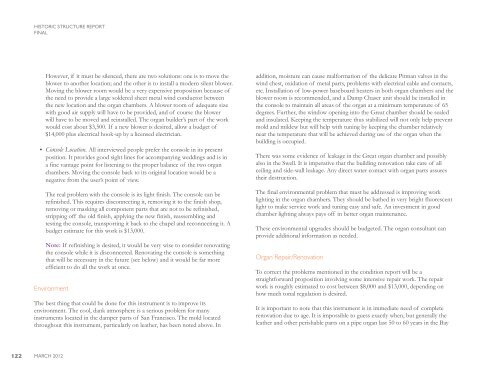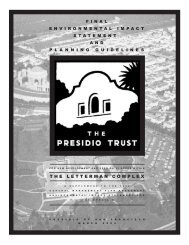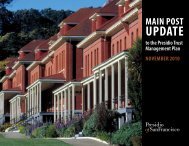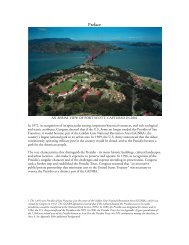Presidio Chapel Historic Structure Report - Presidio Trust
Presidio Chapel Historic Structure Report - Presidio Trust
Presidio Chapel Historic Structure Report - Presidio Trust
- No tags were found...
You also want an ePaper? Increase the reach of your titles
YUMPU automatically turns print PDFs into web optimized ePapers that Google loves.
HISTORIC STRUCTURE REPORTFINALHowever, if it must be silenced, there are two solutions: one is to move theblower to another location; and the other is to install a modern silent blower.Moving the blower room would be a very expensive proposition because ofthe need to provide a large soldered sheet metal wind conductor betweenthe new location and the organ chambers. A blower room of adequate sizewith good air supply will have to be provided, and of course the blowerwill have to be moved and reinstalled. The organ builder’s part of the workwould cost about $3,500. If a new blower is desired, allow a budget of$14,000 plus electrical hook-up by a licensed electrician.• Console Location. All interviewed people prefer the console in its presentposition. It provides good sight lines for accompanying weddings and is ina fine vantage point for listening to the proper balance of the two organchambers. Moving the console back to its original location would be anegative from the user’s point of view.The real problem with the console is its light finish. The console can berefinished. This requires disconnecting it, removing it to the finish shop,removing or masking all component parts that are not to be refinished,stripping off the old finish, applying the new finish, reassembling andtesting the console, transporting it back to the chapel and reconnecting it. Abudget estimate for this work is $13,000.Note: If refinishing is desired, it would be very wise to consider renovatingthe console while it is disconnected. Renovating the console is somethingthat will be necessary in the future (see below) and it would be far moreefficient to do all the work at once.EnvironmentThe best thing that could be done for this instrument is to improve itsenvironment. The cool, dank atmosphere is a serious problem for manyinstruments located in the damper parts of San Francisco. The mold locatedthroughout this instrument, particularly on leather, has been noted above. Inaddition, moisture can cause malformation of the delicate Pitman valves in thewind chest, oxidation of metal parts, problems with electrical cable and contacts,etc. Installation of low-power baseboard heaters in both organ chambers and theblower room is recommended, and a Damp Chaser unit should be installed inthe console to maintain all areas of the organ at a minimum temperature of 65degrees. Further, the window opening into the Great chamber should be sealedand insulated. Keeping the temperature thus stabilized will not only help preventmold and mildew but will help with tuning by keeping the chamber relativelynear the temperature that will be achieved during use of the organ when thebuilding is occupied.There was some evidence of leakage in the Great organ chamber and possiblyalso in the Swell. It is imperative that the building renovation take care of allceiling and side-wall leakage. Any direct water contact with organ parts assurestheir destruction.The final environmental problem that must be addressed is improving worklighting in the organ chambers. They should be bathed in very bright fluorescentlight to make service work and tuning easy and safe. An investment in goodchamber lighting always pays off in better organ maintenance.These environmental upgrades should be budgeted. The organ consultant canprovide additional information as needed.Organ Repair/RenovationTo correct the problems mentioned in the condition report will be astraightforward proposition involving some intensive repair work. The repairwork is roughly estimated to cost between $8,000 and $13,000, depending onhow much tonal regulation is desired.It is important to note that this instrument is in immediate need of completerenovation due to age. It is impossible to guess exactly when, but generally theleather and other perishable parts on a pipe organ last 50 to 60 years in the Bay122MARCH 2012















